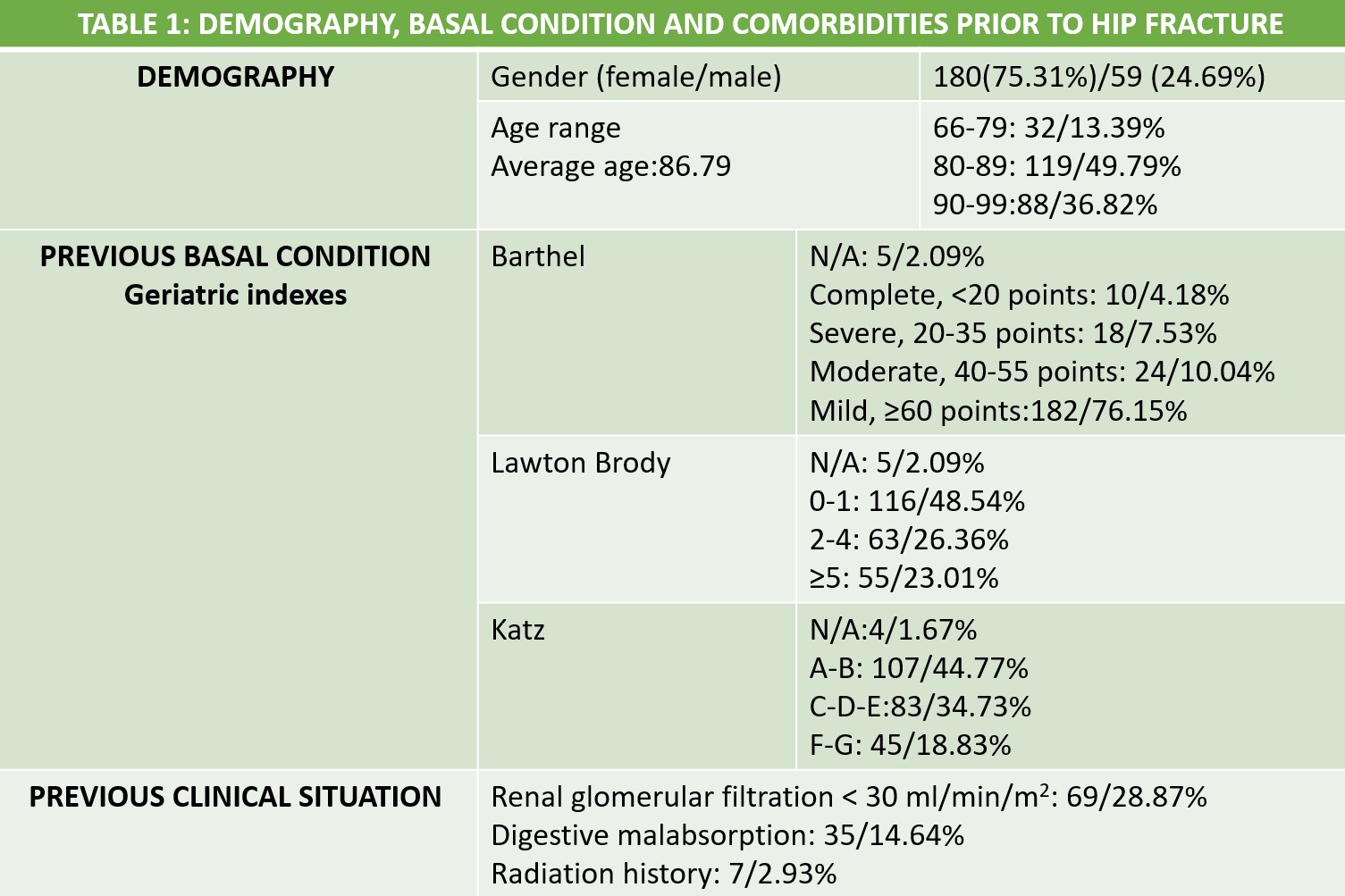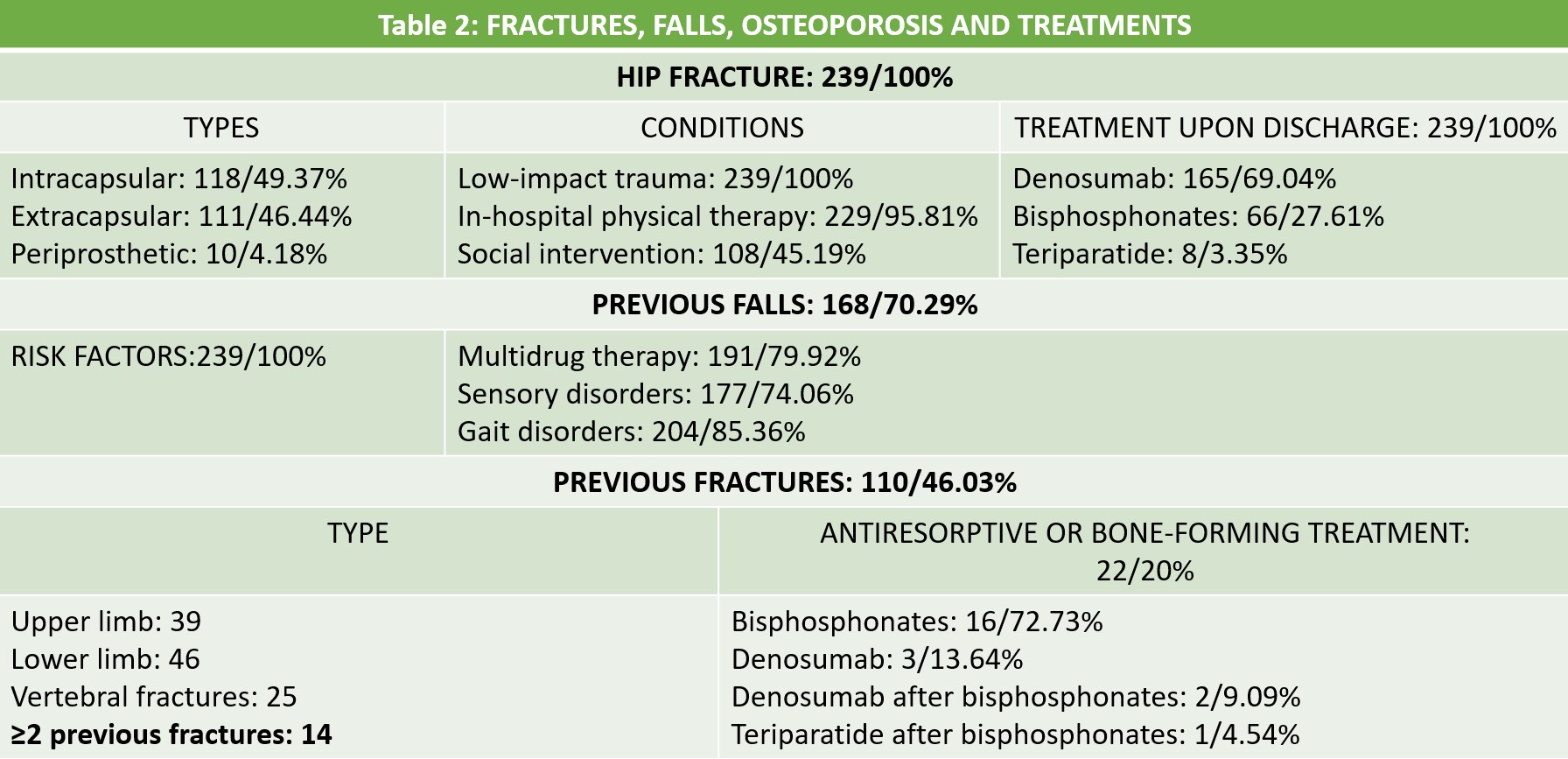Session Information
Date: Tuesday, November 14, 2023
Title: (1996–2018) Osteoporosis & Metabolic Bone Disease – Basic & Clinical Science Poster
Session Type: Poster Session C
Session Time: 9:00AM-11:00AM
Background/Purpose: Osteoporosis is a first-rate problem in an increasingly ageing population. Falls among the elderly are a severe geriatric syndrome with relevant secondary effects. Fractures associated with both entities among the elderly are a cause of high costs and high morbidity and mortality rates. An adequate treatment of osteoporosis and fall prevention are essential factors to safeguard their well-being. The objective of this study is to analyze the clinical characteristics and circumstances of hip fractures, as well as previous fractures and anti-osteoporotic treatments in 239 elderly patients who were admitted with hip fractures in the year 2022 in the Department of Geriatric Care and Traumatology.
Methods: A descriptive, retrospective, observational and longitudinal study was conducted by analyzing the geriatric indexes, and demographic and clinical characteristics of 239 patients aged 66-99 years old who presented with low-impact hip fracture in 2022. The data analysis was carried out with SPSS.
Results: The average age of the patients was 86.79 years, with a range of 66-99 years and a predominance of women (180). During admission, a comprehensive geriatric evaluation of the situation prior to the fracture was completed. At a functional level (Table 1), the Barthel Index revealed that 182 patients had slight dependency in their daily life activities. Regarding their instrumental activities, 55 patients showed a score ≥5 out of 8. After their hip fracture, 229 patients received physical therapy in hospital and 108 patients required social interventions for their subsequent recovery. All the hip fractures were the consequence of low-impact trauma. 168 patients had suffered falls over the last year. However, according to the Downton scale, all of them (239) presented at least one risk factor for falls. These factors are detailed in Table 2. Prior to their hip fracture, 110 patients had suffered a previous low-impact fracture. The most common location was the lower limbs (46). Table 2 shows the different types of fractures. More than one previous fracture was found in 14 cases. None of the patients with previous fractures were being monitored by the Rheumatology Department. Only 22 out of the 110 patients with previous fractures were receiving or had received antiresorptive or bone-forming therapy with bisphosphonates (16), denosumab (3), denosumab after bisphosphonates (2) or teriparatide after bisphosphonates (1). All the patients received anti-osteoporotic treatment as secondary prevention upon discharge, together with denosumab (165), bisphosphonates (66) or teriparatide (8), after ruling out the scenarios included in Table 1 which could advise against their use.
Conclusion: Osteoporosis is an underdiagnosed and undertreated condition. Previous fractures often go untreated, which leads to new fractures that compromise the patients’ independence and quality of life. Hip fractures show the highest rates of morbidity and mortality. Falls play a major role in fractures among the elderly population. Their primary prevention and an adequate osteoporotic treatment must be a priority in elderly care.
To cite this abstract in AMA style:
Miguel Ibáñez B, González Ramírez A, Martínez González O, Turrión Nieves A, Ibáñez Martínez M, Chacón Vélez C, Blanco Ramis L, Martín Martínez M, Hidalgo Calleja C, Montilla Morales C, Gómez Castro S, Blanco Blanco J, Pablos Hernández C. Secondary Prevention of Osteoporosis in Hip Fracture Care for Elderly Patients. Clinical and Functional Profile of Users [abstract]. Arthritis Rheumatol. 2023; 75 (suppl 9). https://acrabstracts.org/abstract/secondary-prevention-of-osteoporosis-in-hip-fracture-care-for-elderly-patients-clinical-and-functional-profile-of-users/. Accessed .« Back to ACR Convergence 2023
ACR Meeting Abstracts - https://acrabstracts.org/abstract/secondary-prevention-of-osteoporosis-in-hip-fracture-care-for-elderly-patients-clinical-and-functional-profile-of-users/


